Descrição
Usando a ferramenta Recuperador Hidráulico
Há algumas coisas que você deve estar ciente ao usar a ferramenta Hydraulic Retriever:
Ⅰ Antes de usar você deve tentar abrir e fechar a haste superior e a válvula de alívio de pressão para garantir sua usabilidade.
Ⅱ Antes de usar você deve tentar abrir e fechar a válvula de retorno de óleo e a válvula de direção.
Ⅲ A mangueira hidráulica de alta pressão não deve ser dobrada com força
Ⅳ No processo de pressão da bomba hidráulica, observe se há vazamento de óleo nas diversas juntas da mangueira hidráulica de alta pressão
V A bomba hidráulica manual equipada com este produto é uma ferramenta especializada fabricada por uma fábrica profissional. Recomenda-se a utilização de óleo hidráulico dos graus 32-46 e, para condições de baixa temperatura, dos graus 22-32. Para evitar ferimentos ao operador, observe:
- Não é permitido exceder a pressão máxima de trabalho da bomba.
- A pressão do sistema deve retornar a zero antes do reabastecimento.
- Certifique-se de que o tanque de óleo não esteja cheio demais. É aconselhável que o nível do óleo hidráulico seja mantido 8 mm abaixo da abertura da tampa do óleo. Caso contrário, o reabastecimento durante a operação pode fazer com que o tanque de óleo transborde e potencialmente causar ferimentos.
- A carga deve estar sempre sob o controle do operador.
- A bomba não deve ser conectada à bomba de outro sistema hidráulico.
Bloco duplo Bleek usando instruções
Uma válvula de bloqueio duplo é uma das principais ferramentas da ferramenta recuperadora hidráulica. É um importante membro que contém pressão, bem como um importante departamento de segurança do sistema de dutos.
Tome e coloque precauções de operação
Ⅰ Configure áreas de alerta, sinalização de segurança e não-operadores antes do início da operação, todos saindo da faixa de alerta.
Ⅱ Um detector de gás portátil (sulfeto de hidrogênio ou inflamabilidade) deve ser usado antes da operação para monitorar vazamentos de óleo e gás.
Ⅲ Em todo o processo de operação, locais com alto teor de enxofre devem usar aparelho respiratório de ar, uma pessoa para operar e uma pessoa para monitorar.
Ⅳ Se o solo da área de operação estiver molhado, medidas antiderrapantes deverão ser definidas para garantir a segurança do operador.
Ⅴ A mangueira hidráulica de drenagem deve ser colocada vazia na direção do vento. Verifique o ambiente ao redor antes da descarga, informe o restante do pessoal para ficar longe, abra lentamente a válvula de ventilação, diminua o alívio da pressão em velocidade lenta para evitar que a mangueira hidráulica salte e machuque as pessoas e use um balde para coletar o líquido e gás descarregado durante a descarga.
Ⅵ Ao operar, você deve usar equipamento de proteção e ser supervisionado;
Ⅶ Ao remover o parafuso limitador, opere na lateral do parafuso limitador para evitar que o parafuso limitador seja ejetado e machuque pessoas.
Ⅷ O operador observa a pressão da tubulação a qualquer momento e ajusta oportunamente a pressão operacional da ferramenta hidráulica de colocação e colocação.
Ⅸ Use luvas de proteção limpas ao instalar um novo cabide.
Manutenção da Ferramenta Recuperadora Hidráulica
Para garantir o seu funcionamento sem problemas e manter as suas boas condições de funcionamento a longo prazo, a manutenção correta e regular é muito importante.
Introdução à manutenção
Inspeção de rotina antes de usar
Depois de armazenar um período, a inspeção é obrigatória para garantir que a ferramenta recuperadora esteja em estado executável. O tempo de inspeção descrito é suposto após a última utilização da ferramenta e já foi limpa e mantida.
Se a ferramenta recuperadora for usada durante vários dias, esta verificação também deverá ser realizada diariamente até a primeira operação do recuperador.
Ferramenta de recuperação hidráulica
Verifique se todas as peças estão presentes e se estão limpas e intactas. Verifique a vedação interna da seguinte forma:
Conecte as duas mangueiras hidráulicas da bomba à ferramenta take-and-place.
Defina a bomba para “INSTALL” e comece a bombear.
A biela deve se estender de maneira suave e uniforme.
Continue bombeando até que a haste de conexão esteja totalmente estendida e o manômetro na bomba indique 100.
Mantenha a pressão por 1-2 minutos para ver se ela se estabiliza e não cai significativamente.
Ajuste a bomba para “RETRIEVE” e bombeie até que a biela esteja totalmente retraída.
A biela deve retrair suave e uniformemente.
Continue bombeando até que o manômetro da bomba indique 100 bar.
Mantenha a pressão por 1-2 minutos para ver se ela se estabiliza e não cai significativamente.
Se a pressão cair mais de 20-30 bar durante qualquer uma das etapas acima, as vedações internas deverão ser inspecionadas e substituídas, se necessário.
Verifique se o anel de vedação que conecta a porca do martelo (para vedação com a válvula de isolamento) está presente e não está danificado.
Válvula de Sangramento
Verifique se todos os componentes estão presentes, especialmente os parafusos que prendem o corpo da válvula.
Verifique se o exterior e o interior da válvula de isolamento estão limpos e intactos.
Verifique se a válvula de isolamento pode ser aberta e fechada facilmente.
Verifique a superfície da esfera da válvula quanto a arranhões profundos ou outros danos. (Pequenos arranhões geralmente não causam problemas).
Verifique se o anel de vedação na parte inferior da válvula de isolamento (usado para vedar entre o corpo da junta do tubo) está presente e intacto.
Manutenção Programada
Não há período de manutenção fixo. Usando o tempo e os tempos de operação, determine o período. As condições de utilização da ferramenta determinam a sua manutenção programada.
Se a ferramenta recuperadora for usada em um sistema de tubulação que contenha grandes quantidades de areia ou outros detritos, poderão ser necessários procedimentos de manutenção frequentes para manter a ferramenta recuperadora adequadamente limpa durante a operação. Em casos graves, como quando há uma grande quantidade de areia no sistema de tubulação, pode ser necessário limpar as ferramentas recuperadoras após cada operação de recuperação. Isto evita grande desgaste e/ou outros danos no interior da ferramenta de recuperação hidráulica.
Manutenção após uso
Após a conclusão de uma série de operações de colocação e colocação, a ferramenta hidráulica de colocação e colocação é armazenada por algum tempo e deve ser desmontada, limpa e inspecionada de acordo com as etapas a seguir.
Ferramenta hidráulica take-and-place de dupla ação
Desmontagem e limpeza
Conecte a mangueira hidráulica à bomba. Ajuste a bomba para “RECUPERAR” e bombeie até que o cilindro interno (2) e a biela (3) estejam totalmente retraídos na ferramenta
Afrouxe os seis parafusos do cabeçote do cilindro mestre (22) e remova o cabeçote do cilindro mestre (6) e o anel protetor (7).
Coloque a ferramenta de recuperação na caixa receptora de óleo e bombeie lentamente (no modo “RECUPERAR”) até que a vedação na extremidade traseira do cilindro interno saia do cilindro mestre (1). Coloque a vareta na outra extremidade do cilindro principal e, em seguida, empurre lenta e cuidadosamente o cilindro interno para fora do cilindro principal. Observe que assim que o cilindro interno for solto do cilindro mestre, todo o óleo da ferramenta de coleta fluirá para fora, portanto, certifique-se de manter a abertura do cilindro mestre acima da caixa de recebimento de óleo. Observe também que o cilindro interno está cheio de óleo hidráulico, que fluirá pelos quatro orifícios do cilindro.
Desparafuse (13) da extremidade da biela e empurre a biela para fora do cilindro interno.
A ferramenta Retriever agora foi totalmente removida para limpeza e inspeção.
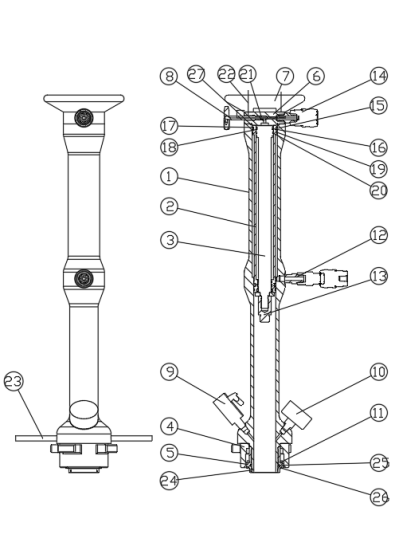
As etapas a seguir (6 e 7) são executadas somente se a porca do martelo (11), o manômetro (10), a válvula de sangria (9) ou a válvula do cabeçote (8) estiverem com defeito ou apresentarem vazamento associado a esses componentes.
Afrouxe o parafuso M5x5 (11) na porca de acoplamento solta (5). Desparafuse a porca do martelo do cilindro mestre (usando uma chave Allen especial) e, em seguida, remova a porca do martelo (4).
Desparafuse o manômetro (10) e a válvula de sangria (9) do cilindro.
Desparafuse a haste do cabeçote (8). Se algum componente restante (engates rápidos e manípulos) estiver danificado, estes também deverão ser removidos, inspecionados e substituídos conforme necessário.
Remova todos os O-rings, retentores e anéis de desgaste, mas deixe o anel anti-incrustante no cilindro interno no lugar. Esses anéis são facilmente danificados quando removidos, portanto, só devem ser removidos se estiverem desgastados e precisarem ser substituídos.
Limpe completamente todos os componentes, especialmente o interior do cilindro mestre, com um limpador adequado,
O-rings e anéis de desgaste e suas ranhuras no cilindro interno e na biela.
10. Verifique cuidadosamente as vedações e os anéis de desgaste. Se alguma vedação estiver arranhada ou apresentar outros sinais de desgaste, ela deverá ser substituída. Se precisar substituir o anel anti-incrustante no cilindro interno, consulte as instruções “Substituição do anel anti-incrustante” na próxima seção.
11. Verifique se há danos nas peças, especialmente na superfície interna do cilindro principal e no cilindro interno.
Certifique-se absolutamente de que todas as superfícies roscadas estejam livres de partículas (areia, partículas de metal, etc.) e devidamente lubrificadas antes de encaixar os componentes individuais. Isto é especialmente importante ao montar a porca do martelo no cilindro mestre. Use um lubrificante antiaderente de alta qualidade.
Após todas as vedações terem sido instaladas na posição correta, aplique graxa para anéis de vedação nas vedações, especialmente antes da biela ser instalada no cilindro interno, antes do cilindro interno ser instalado no cilindro mestre e antes da porca do martelo ser instalada no cilindro mestre.
Tenha cuidado ao montar as peças novamente. Deve-se tomar cuidado especial para garantir que as vedações não sejam danificadas durante a montagem dos componentes.
Se os engates rápidos (12, 14) forem removidos do cilindro mestre para manutenção ou substituição, certifique-se de que sejam reinstalados no local correto. A rosca interna deve ser instalada na cabeça da válvula da ferramenta take-and-place, e a rosca externa deve ser instalada no “meio” do cilindro mestre da ferramenta take-and-place.
Importante! Se você quiser substituir os parafusos que prendem a ferramenta, certifique-se de substituí-los por novos parafusos originais da EMT. Caso sejam utilizados outros tipos de parafusos, a recuperação hidráulica de dupla ação não será mais garantida.

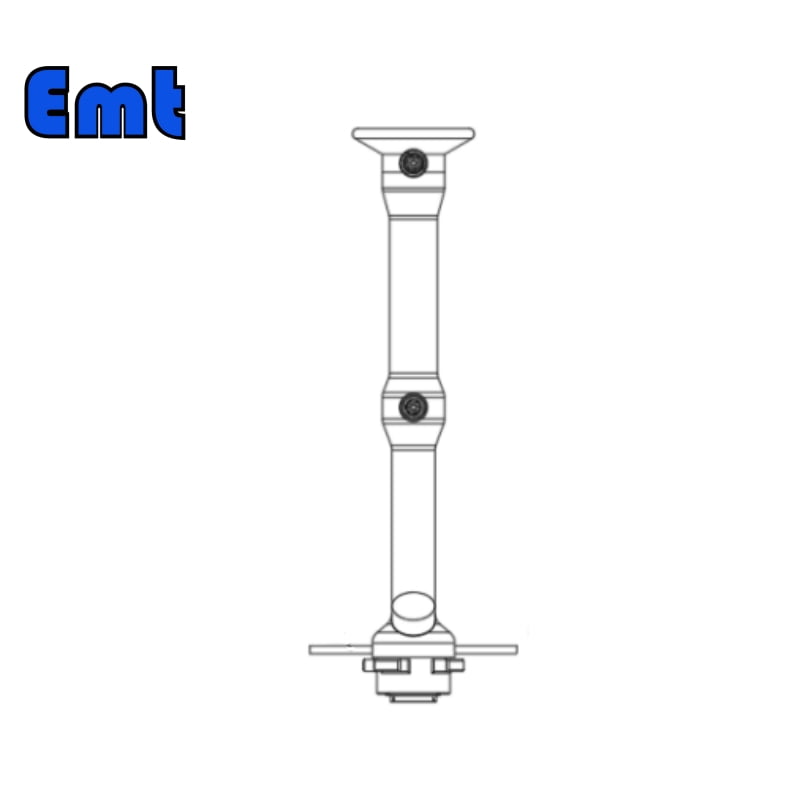
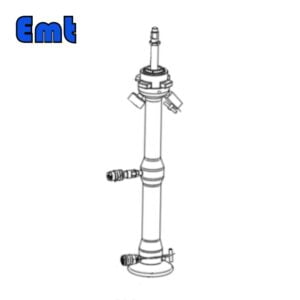
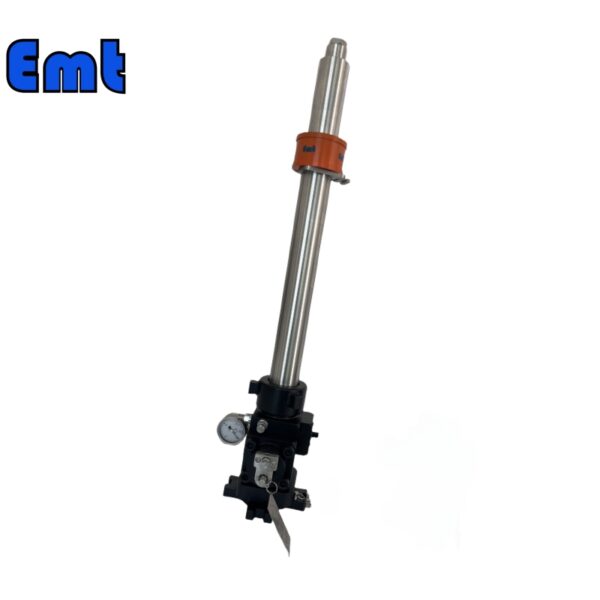
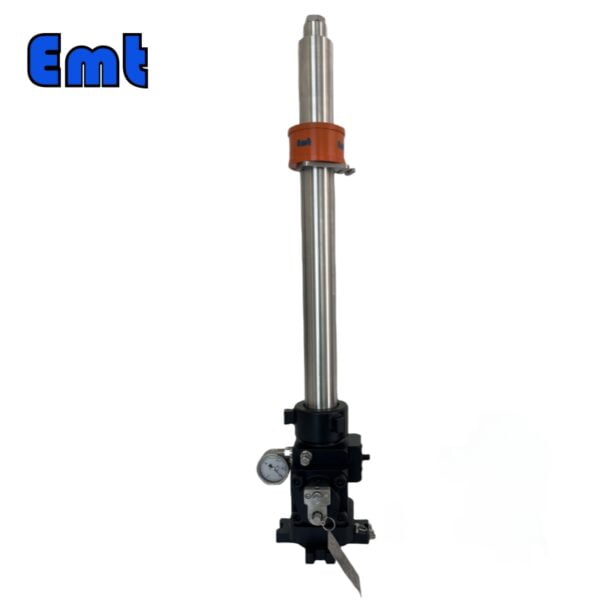
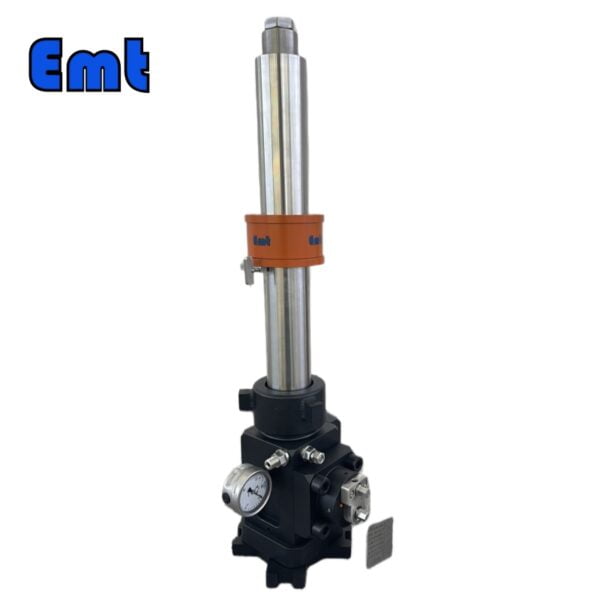
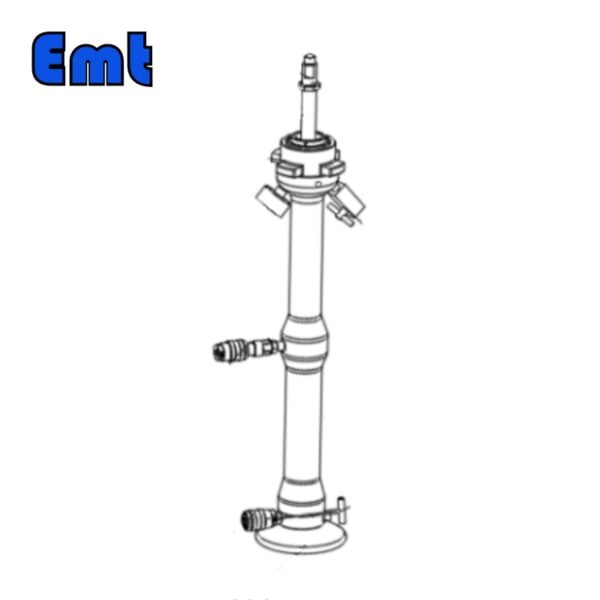
Avaliações
Não há comentários ainda.